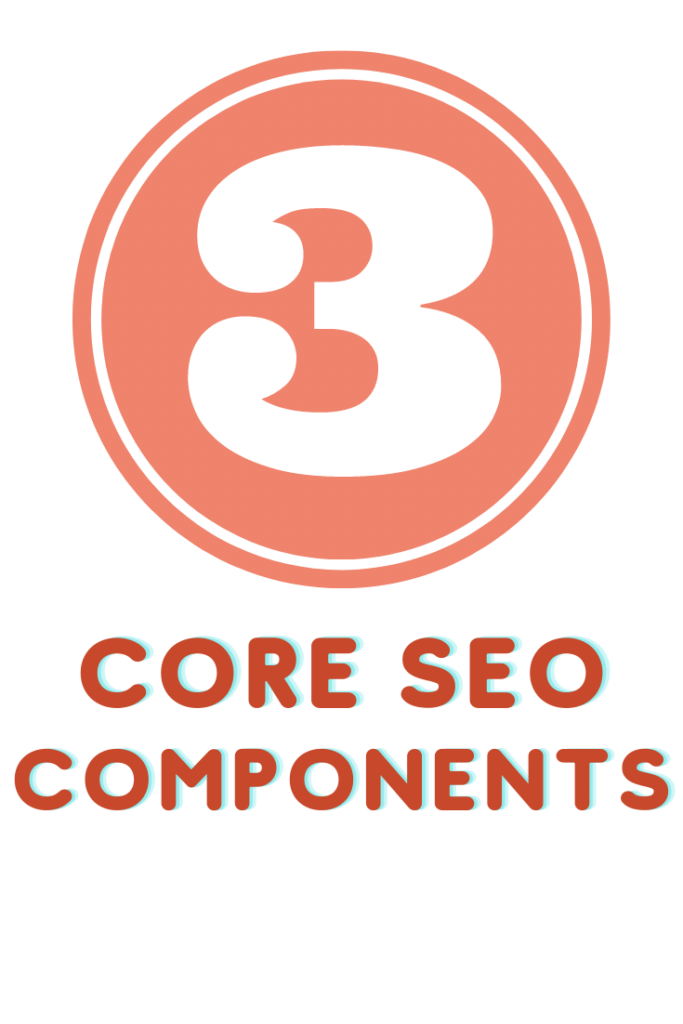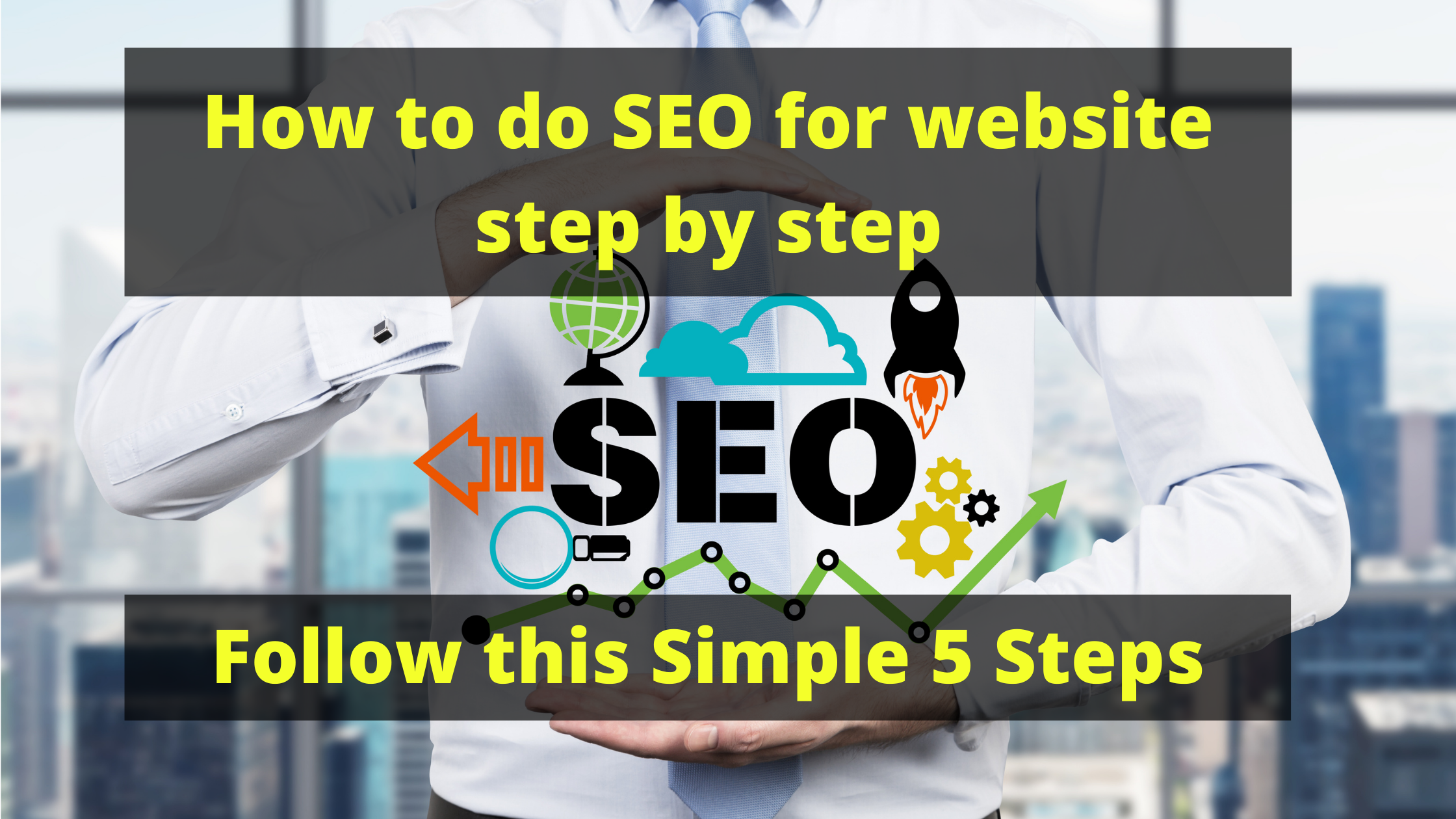
Before I get how long it takes to work, let’s talk briefly about what SEO is. SEO – Search Engine Optimization is the practice of a set of techniques that aid online success by creating your presence, typically a website. This practice of SEO, a collection of activities, if done systematically, will give your website visibility on the search engines, getting you free-organic traffic. Generate traffic by matching specific queries by searchers. You can then convert into your customers. So visitors to your website, therefore build your sales and revenues.
In summary, Sales made on your website can come simply from setting up your SEO correctly. Now that I have your attention, I’ve tried to distill down the components and the activities into a brief list so you can consume the material and hit the ground running. Get the most out of this article. Download the list of Six Essential activities that will boost your SEO here:
Let’s get into it.
The Core three components of SEO
The Three components that go into SEO include On-Page SEO, Off-Page SEO, and Technical SEO.
When my partner Nagu and I first started talking about SEO, we could anticipate overwhelming you folks. I want to define the three components that comprise SEO briefly. Let’s turn our attention and focus very narrowly on six primary SEO activities that will support all three SEO Components. You can visualize the 3 SEO Components like the legs of a three-leg stool.
3 SEO factors are On Page Seo, Off Page Seo, and finally, technical SEO. Once you understand the three SEO elements, let’s then go right into the six activities and take some action. Remember, your actions drive your attitude. The confidence is in the doing.
Focusing on these three SEO elements, commit to building a flexible SEO strategy. Google is continuously updating to drive powerful results and adaptable enough to apply to all websites. Successful SEO strategy must take into account the entire web ecosystem.
On-page SEO
Briefly, On-page SEO optimizes individual web pages to rank higher and earn more relevant traffic. Search engines look at both content and HTML source code as On-page.
Off-page SEO
In contrast, off-page SEO refers to links and other external signals. With experience and over time, you’ll see that some of your content simply is not viewed. The strategy of “go with the winners” is what we use and recommend. Pages on your site with the most impressions or lead magnet downloads are the ones we want to improve upon. This strategy lets us see the content that is working and directs us to do more of that type of content.
The pages with little or no traffic usually pull-down or at least review before removing. Maybe there is something structurally wrong with it. This leads me to…
Off-Page SEO, aka off–site SEO, include actions taken outside of your own website that impact your rankings within search engine results pages (SERPs). By linking to or promoting your website, you are essentially vouching for the content’s quality.
Technical SEO
And finally, Technical SEO, so-called because it has nothing to do with the website’s actual content or with website marketing and promotion. The thrust of technical SEO is to optimize the infrastructure or architecture of a website. We want to optimize the website for the crawling and indexing phase. With technical SEO, you can help search engines access, crawl, interpret, and index your website without any problems.
Why is SEO so important to an online business?
SEO is the practice of a set of techniques that facilitate your online success. SEO is a systematic way of creating your presence and visibility on the search engines, so you can then get organic traffic. That free traffic can be converted into your customers and therefore build your sales and revenues. Are you ready to put in place your own SEO strategy? Learn more with Googles’ SEO starter guide.
How long does it take to work (SEO)?
Depending on how fast you produce and publish your ideas, within 1-6 months as a side hustle, you can get your website crawled by google and ranked. Also, depending on how competitive a Niche is, it could be longer or shorter. It’s essential to understand what the competition is within the Niche you want to establish your online business. Do some research. Find out what you’re up against. Does that sound fair?
Be prepared to put in the work, then there is no need to read on. The good news is that the work is specific. The activities are described just below.
Nagendran and I always say, “if in 5-10 minutes, you learn something new that will make your activities more effective, that is time well spent.”
We’ve included, The Top Six SEO activities you can do that have the most impact on your business. Download it here:
Why does it take SEO so long to work?
Though the AI is very powerful, there is a mountain of pages and data that are added in the form of websites every moment of every day. It takes a lot of observation and data collection to index all the content. Due to competition, SEO takes a while to rise in the rankings. It can also be challenging to catch up with competition because they have been around for longer. If a website is continuing to work at SEO, produce content, and refine titles and tags.
What we are seeing is that within 6 months.
You will start to see traffic increase for keywords within your Niche and your brand name sometimes within 2 weeks. This is true in low competition niches. However, it may take 12 months for high competition terms. Depending on the Niche and your competitors’ activities, it could be longer or shorter. If you’re launching a new website, you can look to 3-6 months depending on the competition for the words if you’re going after niche terms or local terms.
Most businesses that Nagu and I work with or work who commit to the six activities mentioned above see results right away. Revenues usually begin within 3-6 months. We see a peak in activities after 18-24 months. As you add more content, You will see growth in traffic and revenues continue.
Look at building a website that is SEO friendly, the same way as building a relationship. It takes time and attention.
Nagu Kevin
You want a site that is easy to read and make sense of for the AI bots indexing the site. More importantly, you want to include engagement factors so that visitors to your site stay on your site. We call it stickiness when visitors stay on your site and consume content. Perhaps they download a list or sign up for your newsletter. Always include a call to action.
If you’ve ever seen one of my YouTube videos, I usually sign off with, “Remember this, my friends, Specialized knowledge with consistent action leads to huge gains over time.”
Experience has demonstrated it’s true. Actions drive attitude.
If you have a vision Of where you want your website and your online presence to be, you just steadily work at it until you have built a volume of work targeted to a specific audience.
What’s involved in Getting my Site Ranked and Seen?
How authoritative is the domain? How many links do you have to the main home page?
As well as the individual pages on the site. How great is the content, how stiff is the competition, and what is the competition doing to maintain their rankings.
You are building a new site, you can leverage your existing online authority. For example, I have 200,000 views and over 1k followers to my YouTube channel about digital marketing. Though not specifically in SEO, I can rely on that authority anytime I’m talking about Digital products or Marketing. SEO has everything to do with marketing, so I can leverage that by recording a YouTube video every time I write an article. This is called the omnichannel approach.
Repurpose your existing materials
Save time by repurposing the media materials you produce. Use your imagination. Remember, you have unique gifts that no one else has. You bring the insights of your own unique experiences. Some folks are going to love you. Others will be repelled by you. This is natural, so don’t be alarmed or discouraged.
If you think creatively, you can produce lots of material, but you have only done the work one time. A YouTube video recording can be turned into a blog post. For each post, you can add pictures and graphs, and other visual media. Link out to the original Video. A video recording can be turned into a podcast. A podcast can be offered as a digital download, and a top 10 list used as a lead magnet.
Retarget your audiences
If you have the money, send out a Fiverr gig each time you post, spend $2-$5 and have someone design a lead magnet if you are coming up with top 10 lists. People love to download stuff, takeaways, or summaries of the critical points of what you’re writing about. A lead magnet is something of value a potential buyer downloads in exchange for their contact information. Once you have a laser targeted potential buyer, you can retarget them with future offers via email. Instead of people visiting your site never to return again, you have a way of keeping in touch with them. Did you know that email offers a 38:1 return on investment? That’s? Right, for every $1 you spend on email advertising, you can make a $38 (actually $38-$42) return.
You can offer niche-specific products and resources moving forward via email. This way, it’s easy to build a laser targeted audience. You don’t need a vast mass of leads. You want loyal followers of your material. Regularly pair down your list to only those that are consuming your follow up emails. Click here to download our beginners guide to email marketing:
Get real jump in traffic
On a more established website, you optimized for keywords, and you have existing links already and are naturally ranking. Hire an SEO company and pay an expert to optimize each page with keywords and tags, backlinks, add graphics, videos, clickable gifs, or infographics. Once each page is optimized for the right term, you’ll begin to rank for terms you always wanted to rank for quickly, say 4-12 weeks, and you’ll see a real jump in traffic, sometimes 400% month over month.
Along with social media and content marketing, you’ll see an immediate bump in traffic and visits running some AdWords. Keep checking. Within four-six months for the impression count should go up, and within your Google Analytics, you should see traffic from Google other than terms from your brand name. What do I mean? You should see some impressions for keywords within your space but outside of your brand name.
Some website platforms will help you structure your content, so it ranks easier.
Examples are In my article here: Were I listed the top 10 best SEO platforms,
What do you do while waiting for SEO to work?
With Google first and Facebook second, we forget about YouTube in third place. It’s ranked as the third most visited site globally and gets over 3 Billion views per day. We can tap into this vast traffic source by utilizing Video while waiting for our SEO work to pay off.
Download the YouTube SEO guide here:
Backlinking content, both internally and externally.
What do you mean by backlinking?
Basically, we want to refer to other material on the web, just like when you’re writing a technical paper, you have footnotes for references. We all learned footnotes in 5th and 6th-grade English class. Give credit where credit is due. Backlinking is very similar. SEO is based on authority. If your website is attracting views, then Google sees that as general interest in your material. The more sticky your site, the higher Google rates you. That is where internal backlinking really comes into play.
Since my partner Nagu and me write lots of content consistently, we are always referring back to our own content. This previous content is on the same site, just on a different page. I can backlink to this content and keep people on my site for longer. We call this stickiness of a place. This gets back to the user experience.
Google sees user experience as their highest priority, and so should you. That’s one of the things I love about creating content. It’s’ the world, according to Kevin.
All I have to do is talk about what my experience of being in business for 30 years has taught me. I started managing business first for the Navy in 1984, the same year, the internet was launched. I’ve had the joy of seeing the internet and all of the marketing and information system strategies grow up the entire time I’ve been in business.
Remember, the purpose of writing content or a blog is to provide value. Keep that in mind and narrowly focus on delivering content. The search numbers in the Billions of daily searches and queries will discover your Niche specific website as well as your value-rich content. If space or Niche is competitive, then compete at a different level. If most of the posts blog with pictures, then make lists with sweet graphics and videos. Since videos embedded in a blog don’t get many social shares, instead of us clickable gifs or animated doodles.
If you’re seeing lots of blogs that answer Why but they are massive 5-10000 word articles, don’t try to compete by writing 20,000 words. Instead, write short quippy articles of 750 words and backlink them to a matching youtube video. Be sure to match Title, Tag, and 2 long-tail keywords in the article. When creating a page for the article, be sure that the keyword is in the title. Title, tags, and that long-tail keywords should be in the top ½ of the page. Ideally, you want 1-3 backlinks to authoritative sites and articles or infographics on each 1 page of content you publish. We also like to add 1 internal link/article that links back to our own previous blogs or articles, top 10 lists, or youtube videos.
What are the keywords associated with your Niche?
That should be a relatively finite list of keywords. Once you have written about all of those keywords, start with the long-tail keywords. Remember, search intent is about information or it’s transactional. Transactional means there is a purchase involved. Ironically very often, the search query is simply information gathering before making a purchase. Getting back to long-tail keywords, they are what and how questions. So, you guessed it, ranked terms and articles with those long-tail keywords included rank really high on Google. As we’ll see below, Google dominates organic search with a 94% share of all searches.
You should already be getting a lot of traffic for your brand name, but you should be getting traffic for keywords outside your brand name. Even if not a lot, you should be getting traffic from key terms that aren’t your brand name within the first six months. Things should start really kicking in within two years. That’s when you’re going to see the bulk of your SEO growth. By then, you’ve built up your authority and trust in Google, and you just start ranking for almost anything.
Now, here’s a caveat if you’re not building links and not writing a lot of content. You’re not getting social signals to your site. It can take even longer to get rankings so to get results within the time frames, you need to be,
- Publishing at least one blog post a week
- Building at least five to ten links a month
- Promoting your content.
- Repurpose the lead magnet portion of your blog article and post on Facebook, Twitter, and any of your other social profiles and be getting engagement.
You can also link out to the page on your website, but be careful. You may need a link Cloaker, depending on what type of page you’re linking out to from your site.
When posting articles on LinkedIn, it’s recommended you post the entire article.
Summary
First, begin to turn out content with targeted keywords and, perhaps more importantly, long-tail keywords.
A straightforward method to find long-tail keywords is to use Google Search. Type in the keyword, and a dropdown will show you the other terms searched for, use the top 5 and start answering your blog questions. Four other excellent free sources for long-tail keywords are Google Trends, Keywords Everywhere, Ubersuggest, and Answer the Public.
Many website platforms are automatically structured to boost your SEO with Head Terms, tags, and keywords organizers built-in. You fill in the blanks, and the XML site structure will organize the information for the AI bots to crawl the site.
Follow thru on the four actions listed just above. Publishing, Building links, Promoting content via social media and paid targeted ads, and repurposing and content you publish into a multi-channel approach, you’ll get dramatic results within the first three months. Within the first 24 months, you should see your traffic peak.






